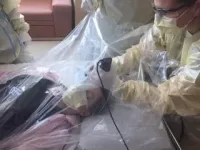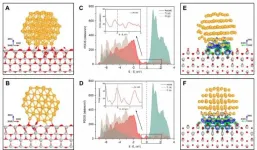Study shows when housing quality is poor, children suffer
Holes in floors, cracks in walls, plumbing issues and/or problems with pests are linked with overall poorer pediatric health and higher health care use in a nationally representative study.
2021-01-28
(Press-News.org) Housing instability and homelessness are widely understood to have an impact on health, and certain housing problems have been linked to specific childhood health conditions, such as mold with asthma. But it has not been clear how overall housing quality may affect children--especially those who are at risk from other social determinants of health such as food insecurity or poverty.
A new nationally representative study in the Journal of Child Health Care, led by researchers at Nationwide Children's Hospital, has found poor-quality housing is independently associated with poorer pediatric health, and suggests ways health care providers and housing programs may address those findings.
"We are really trying to pick apart the social determinants of health. What happens to a child's health if the child is hungry? What happens if a parent can't pay rent?" said Kelly Kelleher, MD, senior author of the study and vice president of Community Health at Nationwide Children's. "What we found in this study is that when housing quality is a problem, children suffer. And children are suffering now."
The authors based the study on the 2014 U.S. Census Survey of Income and Program Participation, ultimately considering 12,964 children 2-14 years of age across the country. As part of the survey, parents were asked about their children's overall health, number of medical visits and number of hospitalizations. They were also asked about the quality of their housing in four specific categories: holes or cracks in walls or ceilings; holes in the floor "big enough to catch your foot on"; plumbing features (including hot water heaters and toilets) that do not work; and problems with pests such as mice and roaches.
The study found each additional housing problem was associated with 43% greater odds of having a poorer health status.
"It was important, however, to account for other factors that are understood to impact health, and so the study used a modeling strategy that went beyond housing quality alone," said Samantha Boch, PhD, RN, the lead author of the study who completed it as a post-doctoral fellow in Nationwide Children's Patient-Centered Pediatric Research Program. She is now an assistant professor at the University of Cincinnati College of Nursing and an affiliate faculty member of the James M. Anderson Center for Health Systems Excellence at Cincinnati Children's Hospital Medical Center.
"Even when you adjust for demographic factors like race, ethnicity and disability, and housing-related issues like inability to pay rent or neighborhood safety, poor housing quality has an independent association with poorer health and higher health care use," said Dr. Boch.
When demographic factors were considered, each additional housing problem was associated with 18% greater odds of poorer health; when other housing issues were considered, there were 16% greater odds.
The authors also found poor housing quality was independently associated with a greater number of medical visits for children (as were inability to pay utilities, rent or mortgage and living in a nonmetropolitan home).
Dr. Kelleher says these findings reinforce the need for social determinants of health screening, and suggest housing quality, not just homelessness or housing insecurity, should be part of those screens. The study also puts a national lens on the convergence of health and housing Nationwide Children's has long seen locally through its Healthy Neighborhoods Healthy Families initiative, which has now built or helped improve approximately 400 homes in traditionally disadvantaged Columbus neighborhoods.
"We know anecdotally, from our experience in our own backyard, that housing quality impacts health," said Dr. Kelleher. "We can now say it's true nationally, and new housing isn't the only thing that matters--improving existing housing may be just as important."
INFORMATION:
ELSE PRESS RELEASES FROM THIS DATE:
2021-01-28
As states and municipalities begin to roll out mass vaccination campaigns, some people have dared to ask: When will it be safe to resume "normal" activities again? For those in most parts of the United States, the risk of COVID-19 infection remains extremely high.
People now have access to better real-time information about infection rates and transmission at the county or city level, but they still need a framework to help them decide what is safe to do. Social distancing and shutting businesses have reduced the number of cases, but there is mounting pressure to reopen businesses and classrooms.
Life is likely to continue in this limbo for some time. A new model co-authored by ...
2021-01-28
A University of Otago study explored factors which influence Americans' levels of concern over climate change, providing discussion on how those factors could impact mitigation efforts.
A key thread of the research examined the ability of people to visualize the future. Results showed that while 74 per cent of respondents were concerned about climate change, only 29 per cent discussed lower carbon options when asked to describe travel in the year 2050.
"This suggests actively envisioning a sustainable future was less prevalent than climate change concern. So while the majority were concerned, ...
2021-01-28
UNIVERSITY PARK, Pa. -- People who do not accept inequality are more likely to negatively evaluate companies that have committed wrongdoings than people who do accept inequality, and this response varies by culture, according to researchers at Penn State. The team also found that companies can improve their standing with consumers when they offer sincere apologies and remedies for the harm they caused to victims.
"Some prominent examples of company moral transgressions include Nike's and Apple's questionable labor practices in developing countries, BP's oil spill in the Gulf of Mexico and Volkswagen's emissions scandal," said Felix Xu, graduate student in marketing at Penn State.
In their paper, which published on Jan. 22 in the Journal of Consumer Research, the team ...
2021-01-28
Thermoelectric materials, which can generate an electric voltage in the presence of a temperature difference, are currently an area of intense research; thermoelectric energy harvesting technology is among our best shots at greatly reducing the use of fossil fuels and helping prevent a worldwide energy crisis. However, there are various types of thermoelectric mechanisms, some of which are less understood despite recent efforts. A recent study from scientists in Korea aims to fill one such gap in knowledge. Read on to understand how!
One of these mechanisms mentioned earlier is the spin Seebeck effect (SSE), which was discovered in 2008 by a research team led by Professor Eiji Saitoh from Tokyo University, Japan. The SSE is a phenomenon in which ...
2021-01-28
DALLAS - Jan. 28, 2021 - Simulation can be a viable way to quickly evaluate and refine new medical guidelines and educate hospital staff in new procedures, a recent study from UT Southwestern's Department of Pediatrics shows. The findings, published recently in the journal Pediatric Quality and Safety and originally shaped around new COVID-19-related pediatric resuscitation procedures at UTSW and Children's Health, could eventually be used to help implement other types of guidelines at medical centers nationwide.
For decades, U.S. hospitals have used the same standard procedures ...
2021-01-28
"King Solomon made for himself the carriage; he made it of wood from Lebanon. Its posts he made of silver, its base of gold. Its seat was upholstered with purple, its interior inlaid with love." (Song of Songs 3:9-10)
For the first time, rare evidence has been found of fabric dyed with royal purple dating from the time of King David and King Solomon.
While examining the colored textiles from Timna Valley - an ancient copper production district in southern Israel - in a study that has lasted several years, the researchers were surprised to find remnants of woven fabric, a tassel and fibers of wool dyed with royal purple. Direct radiocarbon ...
2021-01-28
(For Immediate Release--Singapore--January 28, 2021)-- In the phase II CodeBreak 100 trial, sotorasib provided durable clinical benefit with a favorable safety profile in patients with pretreated non-small cell lung cancer (NSCLC) and who harbor KRAS p.G12C mutations, validating CodeBreak 100's phase I results, according to research presented today at the International Association for the Study of Lung Cancer World Conference on Lung Cancer.
Outcome in patients with advanced NSCLC on second- or third-line therapies is poor, with a response rate of less than 20% and median progression-free survival of fewer than four months. Approximately 13% of patients with lung adenocarcinomas harbor KRAS p.G12C mutations.
Sotorasib is a first-in-class small molecule that specifically ...
2021-01-28
An international joint research team from the Shanghai Advanced Research Institute of the Chinese Academy of Sciences, along with Zhejiang University and the Technical University of Denmark, reported an in-situ strategy to manipulate interfacial structure with atomic precision during catalytic reactions. Results were published in the latest issue of Science.
The interface between nanoparticles and substrates plays a critical role in heterogeneous catalysis because most active sites are located at the perimeter of the interface. It is generally believed that this interface is immobile and unchangeable, thus can hardly be adjusted in reactive environments. As a result, it has been challenging to promote catalytic activity through precise control of the interfacial ...
2021-01-28
The emergence of SARS-CoV-2 virus variants that are adding twists in the battle against COVID-19 highlight the need for better genomic monitoring of the virus, says Katia Koelle, associate professor of biology at Emory University.
"Improved genomic surveillance of SARS-CoV-2 across states would really help us to better understand how the virus causing the pandemic is evolving and spreading in the United States," Koelle says. "More federal funding is needed, along with centralized standards for sample collection and genetic sequencing. Researchers need access to such metadata to better track how the virus is spreading geographically, and to identify any new variants ...
2021-01-28
BOSTON -- Routine screening of asymptomatic health care personnel (HCP) in the absence of confirmed exposures to COVID-19 is not a recommended strategy for preventing transmission of the coronavirus causing the current global pandemic, according to a new review co-authored by an infectious disease specialist at Massachusetts General Hospital (MGH). The review, published in Infection Control & Hospital Epidemiology, found that such testing is unlikely to affect the transmission of SARS-CoV-2 in health care settings and could even have unintended negative consequences.
Many universities, sports leagues and other institutions require individuals in their organization to undergo routine testing for COVID-19, whether or not they are experiencing symptoms. Current public ...
LAST 30 PRESS RELEASES:
[Press-News.org] Study shows when housing quality is poor, children suffer
Holes in floors, cracks in walls, plumbing issues and/or problems with pests are linked with overall poorer pediatric health and higher health care use in a nationally representative study.




